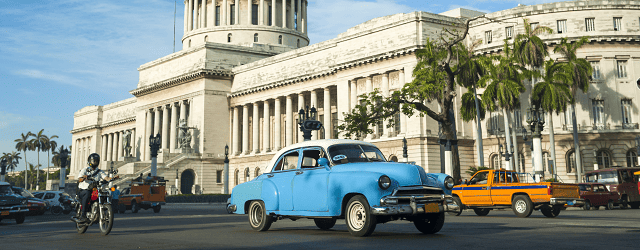As Cuba reopens its economy, the government hopes loosened restrictions and dollarization of international trade will spur expansion.

|
CUBA: VITAL STATISTICS |
|---|
|
Location: Caribbean |
|
Neighbors: United States, Bahamas, Turks and Caicos, Haiti, Jamaica, Cayman Islands, Mexico |
|
Capital city: Havana |
|
Population (2020): 11,325,956 |
|
Official language: Spanish |
|
GDP per capita (2018): $8,821.80 |
|
GDP growth (2018): 2.2% |
|
Inflation (2019): 5.7% |
|
Currency: Confusion because of dual currency system: the Cuban peso and the Cuban convertible peso |
|
Investment promotion agency: ProCuba Center for the Promotion of Foreign Trade and Foreign Investment |
|
Investment incentives available? Breaks on duties; streamlined procedures; special economic zone with tax and customs breaks; majority shareholding in a local company allowed after approval by the government |
|
Ease of Doing Business rank: Not ranked |
|
Corruption Perceptions Index rank (2019): 60 |
|
Political risks: Accusations of resale of Venezuelan oil; limited support from neighbors; US sanctions |
|
Security risks: : Risk of lawsuits in US courts under the Helms-Burton Act; advisable to avoid eating seafood, insufficiently cooked meat, salads, fruit unless peeled personally, water unless boiled, filtered or bottled; insect-borne diseases such as dengue fever |
|
PROS |
|---|
|
Well-educated and trained workforce |
|
Internal political situation stable |
|
High-quality medical and education sectors |
|
Low crime, anti-corruption efforts |
|
CONS |
|---|
|
Limited access to world capital pools |
|
Low foreign exchange reserves |
|
Need to import approximately 80% of all food and fuel requirements |
|
Limited legal rights for foreign interests |
|
External vulnerabilities include climate, raw material prices and dependence on Venezuelan aid |
|
Cumbersome administrative processes |
|
Very complex approval process |
|
Unresolved issues over Fidel Castro’s nationalization of American properties |
|
Sources: Economist Intelligence Unit, Knoema.com, Prensa Latina, Reuters, Transparency International, UK government, US State Department, World Bank, World Population Review, Trading Economics |
|
For more information, check out Global Finance‘s Cuba Economic Report data page. |
Cuba’s economy is slowly powering back up as the government gradually ends its Covid-19 lockdown. But a combination of the health and economic effects of the pandemic, intensifying US-imposed trade restrictions and self-imposed limitations on commerce are preventing the island from fully recovering and further developing.
“Cuba currently faces a perfect storm of challenges,” says Mark Entwistle, formerly Canadian ambassador to Cuba and now managing director of Acasta Capital, a business development and investment consultancy. While some of these issues cannot be tackled immediately, resolving others would go part way toward offering Cubans stronger economic prospects.
Covid-19 seriously exacerbated food and energy shortages, and tourism revenues have been decimated, reducing Cuba’s stores of foreign exchange. The Economic Commission for Latin America and the Caribbean, a United Nations agency, projects Cuba’s economy will contract 8% this year.
The country has suffered a series of external shocks as outside allies have withdrawn support for the Communist regime. Recently, for example; Venezuela, who stepped in after the USSR disintegrated, reduced its aid and trade amid declining oil prices and US sanctions. At one time, the Venezuelan relationship accounted for almost 22% of Cuba’s GDP, according to one estimate.
Meanwhile, US President Donald Trump’s decision to reimpose travel and trade restrictions while piling on additional sanctions and restrictions on remittances has reduced the flow of necessary goods, services and currency. Relaxed rules in the Obama era had drawn strong interest from both tourists and business, expanding economic opportunities, notes Entwistle.
Some of Cuba’s difficulties, however, flow from policies of its own making. These include tight labor controls, the dominant role of state-run enterprises and frequent government insistence on majority control of other businesses. Moreover, Cuba lacks transparency in reported figures. Such factors dampen the enthusiasm of many potential foreign investors.
Some recent developments may signal a new order of sorts. In July, the government liberalized import-export regulations; provided more autonomy for state-run organizations, farmers and local governments; and allowed dollarization of some international trade.
Whether and how soon Cuba can recover to its pre-pandemic economic levels remains open questions. For foreign investors, the risk-reward calculation has changed as well.
Still, while they are not immediately apparent in the midst of the present crisis, Entwistle sees opportunities in mining, tourism, tobacco, renewable energy and the rum business, among other areas.



